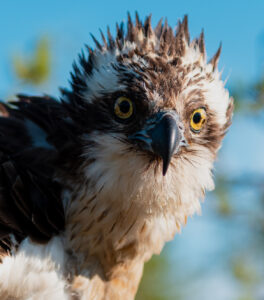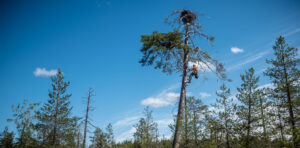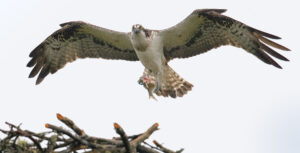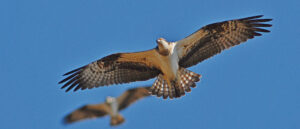Third International Scientific and Practical Conference “Eagles of the Palearctic: Study and Conservation”
Raptors Conservation. Suppl. 2. Proceedings of Conferences
PROJECT “OSPREY IN RUSSIA”: KEY FINDINGS IN 2019–2023
Babushkin M.V., Kuznetsov A.V. (Darwin State Nature Reserve, Cherepovets, Russia)
Sharov A.A. (Company “52dereva”, Nizhny Novgorod, Russia)
Pchelintsev V.G. (“Ecoproject” CJSC, St. Petersburg, Russia)
Sellis U., Sein G. (Eagle Club, Hauka, Viljandi, Estonia)
Shikalova E.A. (Sayano-Shushenski State Nature Reserve, Shushenskoye, Krasnoyarsk
Krai, Russia)
Utekhina I.G. (“Magadan” State Nature Reserve, Magadan, Russia)
Bragin A.V., Futoran P.A. (“Onezhskoye Pomorye” National Park, Arkhangelsk, Russia)
Kholodov E.V. (“Vodlozersky” National Park, Petrozavodsk, Russia)
Delgado M.M. (Biodiversity Division, Joint Research Unit for Biodiversity, High Council for
Scientific Research, University of Oviedo, Mieres, Spain)
Contact:
Miroslav Babushkin babushkin02@mail.ru
Andrey Kuznetsov seaeagle01@yandex.ru
Alexey Sharov 52dereva@mail.ru
Vasily Pchelintsev acerapes@gmail.com
Urmas Sellis urmas@kotkas.ee
Gunnar Sein gunnar.sein@gmail.com
Elena Shikalova e.shikalova@mail.ru
Irina Utekhina steller@magterra.ru
Albert Bragin aapaboloto@yandex.ru
Pavel Futoran blaid008@yandex.ru
Evgeniy Kholodov hunter.kholodov@gmail.com
María Del Mar Delgado delgadomar@uniovi.es
Recommended citation: Babushkin M.V., Kuznetsov A.V., Sharov A.A., Sellis U., Sein G., Shikalova E.A., Utekhina I.G., Bragin A.V., Futoran P.A., Kholodov E.V., Delgado M.M. Project “Osprey in Russia”: key findings in 2019–2023. – Raptors Conservation. 2023. S2: 92–97. DOI: 10.19074/1814-8654-2023-2-92-97 URL: http://rrrcn.ru/en/archives/34900
In Russia, Osprey (Pandion haliaetusnests from the western borders of the Kaliningrad region to the Kamchatka Peninsula, Anadyr River basin, Sakhalin Island, southern Kuril Islands, and Japan. The northern border of its distribution runs along the edge of the northern taiga, forested river valleys in the north. During the Project, the breeding population, migration routes, and wintering sites were determined for the first time for Ospreys inhabiting the north of the European part of Russia, south of Central Siberia (Sayano-Shushenski State Nature Reserve), and in Far East (“Magadan” State Nature Reserve, central part of the Kamchatka Peninsula).
After a significant population reduction because of “harmful predators” control and the use of organochlorine pesticides (until the 1970s), Osprey population stabilizes and gradually grows (2–2.5 times in about 30 years) in most regions of the European part of Russia. It was noted that the species colonized the central and northern regions of Kola Peninsula, Republic of Karelia, Arkhangelsk, and Pskov regions, where nesting had not previously been observed. Previously unknown viable Osprey breeding group was discovered on the coast of the Onega Peninsula of the White Sea (25 pairs; 2 pairs/100 km2km2). In most regions of Siberia and the Far East, reverse trends of population decline occur. The maximum nesting density is observed on coasts of reservoirs belonging to the Volga-Baltic waterway system. The Rybinsk Reservoir (Darwin State Nature Reserve) has the highest nesting density of Osprey in the country (up to 6–7 pairs/100 km2). In the subzone of the southern and middle taiga nesting density ranges in suitable habitats between 1–4 pairs/100 km2, in the northern taiga – 0.8–2 pairs/100 km2, in the forest tundra of the Kola peninsula – 0.1 pairs/100 km2. In remaining areas of the European part of Russia, Osprey is more diffusely distributed, its total population size is 1200–1400 breeding pairs.
In the east of the country (Primorsky and Khabarovsk territories, Amur, Magadan, and Sakhalin regions, Chukotka), the number is declining in most regions, with about 1000–1200 breeding pairs total. In the Magadan State Nature Reserve, a slight decrease in numbers was noted compared to the 1990s. In 2020–2021, no more than 5–6 pairs with a total nesting stock of 12–15 nests bred here near the Kava River and its tributaries. In 2023, a unique to the region Osprey nesting group was discovered here: nests were located on the supports of a power line running along the Plotnikova, Bystraya, and Kamchatka rivers. 42 Osprey nests (16 of them occupied) were found along 280 km of power line.
In 2019–2023, 16 Ospreys were tagged with GPS-GSM transmitters: in the north of the European part of Russia (three adults and seven young birds), in the Magadan State Nature Reserve (two young birds), in the Sayano-Shushenski State Nature Reserve (two adult birds), in Kamchatka (two adult birds).
Ospreys that breed in the north of the European part of Russia winter on the African continent. Unlike Ospreys in eastern Europe, during the autumn migration they cross the Mediterranean Sea from the east and then disperse to their wintering grounds in Africa. Wintering area: from the south of the Mediterranean Sea to the southern coast of South Africa (except for the Sahara) and from the Niger River basin and Lake Chad to the Arabian Peninsula. The distance between wintering grounds and nesting areas is 4000–10550 km. Differences in migration strategies related to gender and age were found. Females and juveniles traveled shorter migratory distances than males and adults.
Siberian Ospreys winter in South Asia. Two adult birds, a male and a female from a pair tagged in one of the nests in Sayano-Shushensky State Nature Reserve, spent the winter in India. The female spent two winters in the southeast of Rajasthan, 3500 km from the breeding territory (N24.5°–24.6°, E74.1°– 4.4°). During the spring migration, it died in fishponds in China after becoming entangled in a net. The male from this pair collided with wind turbine, and later, while trying to take off, died on a power line on the Deccan Plateau (4300 km from the breeding territory). Tracks analysis allowed us to identify a new “bottleneck” on the autumn raptor migration route – through the Karakoram Mountain range (a 200 km area between the upper reaches of the Shimshal and Nabra rivers).
Ospreys native to the Far East winter in Southeast Asia. Two juvenile ospreys from the Magadan State Nature Reserve spent their first year in Western (N3.4°– 3.6°, E101°–101.7°, 7400 km) and Eastern Malaysia (N4.9°–5.4°, E115.9°–116.2°, 6700 km). During the autumn migration, birds crossed the Sea of Okhotsk and flew through Primorye and South Korea. First osprey headed to Taiwan, and then, having flown over the South China Sea, reached the Malacca Peninsula, where it spent the first year and a half (30 km north of Kuala Lumpur). Second osprey crossed the South China Sea and spent two winters and a summer in the north of the Kalimantan Island. After 17–18 months spent in the wintering grounds, sub-adults began to move north: first reached the north of the Sakhalin Island, second – central China.

Female Osprey (Pandion haliaetus) tagged with a transmitter. This osprey currently winters in Central Africa on Lake Victoria. Photo by M. Egorov.

Researcher’s climb to an Osprey (Pandion haliaetus) nest in the Republic of Karelia. Photo by E. Alekseev.


